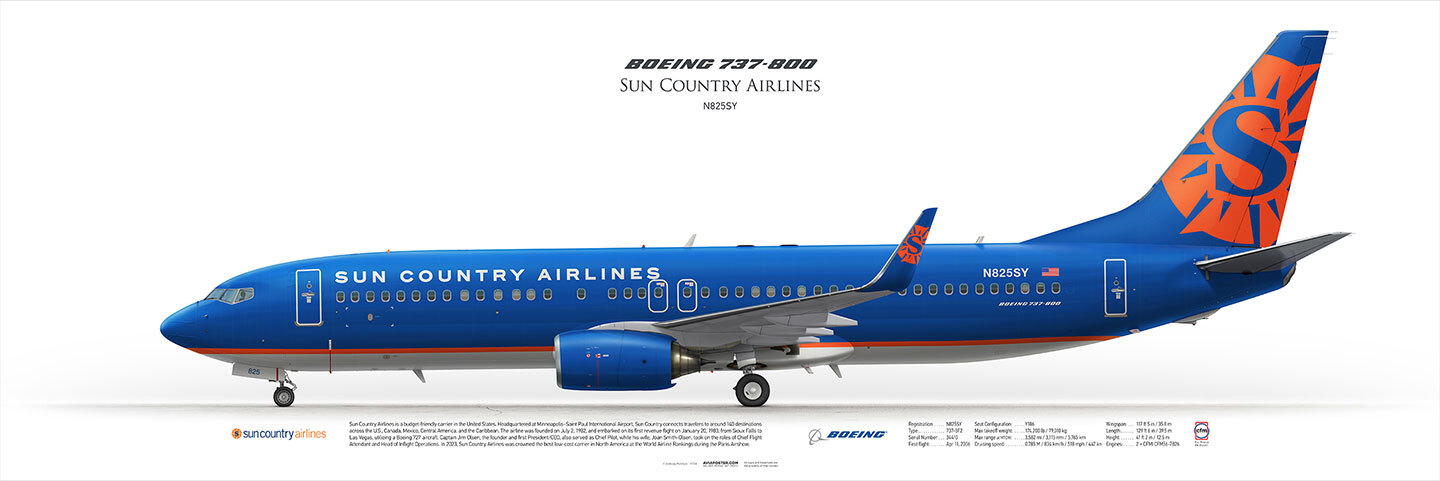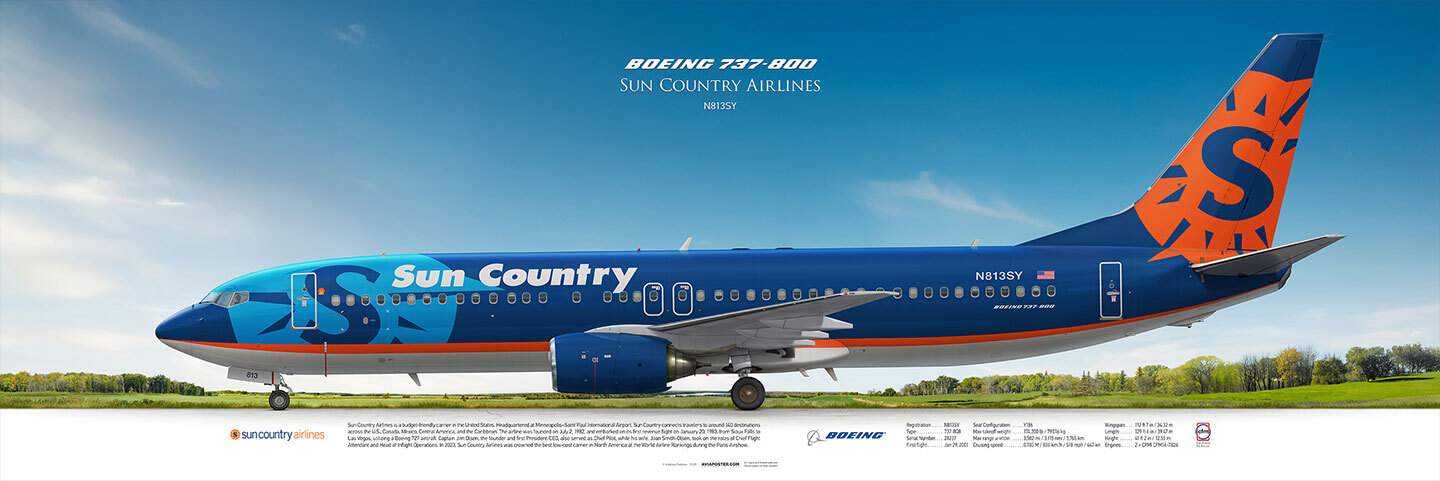Sun Country Airlines is an American airline based at Minneapolis/Saint Paul International Airport (MSP) in Minnesota. Founded in 1982, it evolved from a small charter carrier to one of the leading ultra-low-cost carriers (ULCC) in the U.S., complementing its core operations with charter flights and cargo services for Amazon Air. The story of Sun Country is one of resilience, adaptation, and strategic transformations that enabled it to navigate economic crises, multiple ownership changes, and shifting market conditions. This narrative explores the key milestones in the company’s development, its business model, challenges, and achievements, drawing on historical facts and current data.
Sun Country Airlines was established in July 1982 by a group of former Braniff International Airways employees, which ceased operations in May of that year. Among its founders were pilots and flight attendants who, after losing their jobs following Braniff’s collapse, aimed to create a new airline focused on leisure charter services. The initiative was led by Ken Sundmark, who, alongside Bob Daniels, co-founder of Mainline Travel Inc., proposed the idea of a charter carrier. Captain Jim Olsen played a key role in the founding, becoming the first president and CEO of the airline, as well as its chief pilot. His wife, Joan Smith-Olsen, took on the roles of senior flight attendant and head of flight operations, significantly contributing to the development of the company’s operational structure. Sun Country’s first flight took place on January 20, 1983, from Sioux Falls, South Dakota, to Las Vegas, Nevada, using a leased Boeing 727-200. The initial workforce consisted of just 36 employees: 16 pilots, 16 flight attendants, three mechanics, and one office worker.
In its early years, Sun Country focused on charter flights for tourists, partnering with MLT Vacations and similar tour operators. Its primary routes connected the cold Upper Midwest, particularly Minnesota, to warm destinations like Las Vegas, Florida, and the Caribbean. In 1986, the airline expanded its fleet by leasing a Douglas DC-10 from Northwest Airlines for high-demand routes such as Minneapolis–Las Vegas. By the late 1980s, Sun Country had become the third-largest charter airline in the U.S., behind only American Trans Air and Tower Air. In 1988, its headquarters were established at Minneapolis/Saint Paul Airport, strengthening its regional ties.
By 1991, Sun Country achieved a record profit of $9.7 million, enabling it to double its fleet and workforce. The airline began operating military charters for the Civil Reserve Air Fleet, including flights to Saudi Arabia and Bahrain, further bolstering its financial position. However, the successes of the late 1980s gave way to challenges in the 1990s due to increased competition and economic difficulties.
In the 1990s, Sun Country began transitioning from solely charter services to scheduled flights, launching regular services from Minneapolis to major U.S. cities in 1995. In 1999, the airline was acquired by a Minnesota-based investment group led by William La Macchia Sr., after which it officially became a scheduled carrier, competing with Northwest Airlines. This period saw the expansion of its route network to include international destinations in Mexico and the Caribbean.
However, in 2001, Sun Country faced severe financial difficulties triggered by the economic downturn following the September 11 attacks. In December 2001, the airline suspended all operations and filed for Chapter 11 bankruptcy protection. Despite this, a group of investors acquired its assets, and flights resumed in early 2002. Sun Country continued to grow, adding Boeing 737-800 aircraft to its fleet, marking a shift to narrow-body planes.
Sun Country Airlines was established in July 1982 by a group of former Braniff International Airways employees, which ceased operations in May of that year. Among its founders were pilots and flight attendants who, after losing their jobs following Braniff’s collapse, aimed to create a new airline focused on leisure charter services. The initiative was led by Ken Sundmark, who, alongside Bob Daniels, co-founder of Mainline Travel Inc., proposed the idea of a charter carrier. Captain Jim Olsen played a key role in the founding, becoming the first president and CEO of the airline, as well as its chief pilot. His wife, Joan Smith-Olsen, took on the roles of senior flight attendant and head of flight operations, significantly contributing to the development of the company’s operational structure. Sun Country’s first flight took place on January 20, 1983, from Sioux Falls, South Dakota, to Las Vegas, Nevada, using a leased Boeing 727-200. The initial workforce consisted of just 36 employees: 16 pilots, 16 flight attendants, three mechanics, and one office worker.
In its early years, Sun Country focused on charter flights for tourists, partnering with MLT Vacations and similar tour operators. Its primary routes connected the cold Upper Midwest, particularly Minnesota, to warm destinations like Las Vegas, Florida, and the Caribbean. In 1986, the airline expanded its fleet by leasing a Douglas DC-10 from Northwest Airlines for high-demand routes such as Minneapolis–Las Vegas. By the late 1980s, Sun Country had become the third-largest charter airline in the U.S., behind only American Trans Air and Tower Air. In 1988, its headquarters were established at Minneapolis/Saint Paul Airport, strengthening its regional ties.
By 1991, Sun Country achieved a record profit of $9.7 million, enabling it to double its fleet and workforce. The airline began operating military charters for the Civil Reserve Air Fleet, including flights to Saudi Arabia and Bahrain, further bolstering its financial position. However, the successes of the late 1980s gave way to challenges in the 1990s due to increased competition and economic difficulties.
In the 1990s, Sun Country began transitioning from solely charter services to scheduled flights, launching regular services from Minneapolis to major U.S. cities in 1995. In 1999, the airline was acquired by a Minnesota-based investment group led by William La Macchia Sr., after which it officially became a scheduled carrier, competing with Northwest Airlines. This period saw the expansion of its route network to include international destinations in Mexico and the Caribbean.
However, in 2001, Sun Country faced severe financial difficulties triggered by the economic downturn following the September 11 attacks. In December 2001, the airline suspended all operations and filed for Chapter 11 bankruptcy protection. Despite this, a group of investors acquired its assets, and flights resumed in early 2002. Sun Country continued to grow, adding Boeing 737-800 aircraft to its fleet, marking a shift to narrow-body planes.

In 2006, the airline was acquired by Petters Group Worldwide and Whitebox Advisors. This period proved short-lived: in 2008, the global financial crisis and rising fuel prices pushed Sun Country toward bankruptcy again. The situation worsened when Petters Group Worldwide was implicated in a $3.25 billion financial fraud. As a result, the airline had to cut 45 of its 156 pilots, reduce flights, and introduce fees for the first checked bag. In October 2008, Sun Country filed for Chapter 11 protection for the second time.
Recovery from the second bankruptcy was achieved in July 2011 when the Davis family, owners of Cambria, a countertop manufacturer, acquired the airline for $34 million. Marty Davis, head of Cambria, became chairman of the board. Under new leadership, Sun Country focused on improving operational efficiency and expanding its route network. In 2013, the airline revamped its loyalty program, Ufly, introducing a points-based system tied to spending rather than distance flown, allowing customers to earn free flights faster.
In 2015, Sun Country appointed Zarir Erani as president and CEO, and that year, its net profit reached $27 million. However, in 2016, profits fell 41% to $16 million, leading to Erani’s replacement by Jude Bricker, former CEO of Allegiant Air, in July 2017. Bricker spearheaded a major transformation, converting Sun Country into an ultra-low-cost carrier (ULCC). This involved eliminating premium service classes, introducing fees for baggage and seat selection, and simplifying the operational model to reduce costs. Despite resistance from local communities who viewed Sun Country as Minnesota’s “hometown” airline, the new strategy boosted revenues and competitiveness.
In December 2017, the Davis family sold Sun Country to funds affiliated with Apollo Global Management for an undisclosed amount. Under Bricker’s continued leadership, the airline further developed its ULCC model, offering three economy class tiers: Best, Exit Row, and Standard. In 2018, it launched an updated loyalty program, Sun Country Rewards, replacing Ufly.
A significant step in diversifying its business was a partnership with Amazon Air, which acquired a minority stake in Sun Country in December 2019. In May 2020, the airline began operating cargo flights for Amazon Air. By mid-2024, Sun Country’s cargo fleet consisted of 12 Boeing 737-800BCF aircraft, and in June 2024, it signed a contract with Amazon Air through 2030, planning to expand the cargo fleet to 20 aircraft. This partnership provided stable revenue during off-peak seasons, complementing its leisure-focused core business.
In 2021, Sun Country became a publicly traded company, raising additional capital for growth. In early 2025, Apollo Global Management sold its remaining shares through a secondary public offering. As of March 2025, Sun Country’s fleet comprised 46 passenger and 15 cargo Boeing 737-800 aircraft, serving approximately 140 destinations across the U.S., Canada, Mexico, Central America, and the Caribbean. The airline dynamically adjusted its flight schedules, increasing services during peak seasons like winter and spring breaks and scaling back during low-demand periods.
Today, Sun Country Airlines occupies a unique niche in the U.S. aviation industry, balancing three business segments: scheduled passenger services (70% of revenue), charter flights (20%), and cargo operations (10%). This hybrid model enables efficient resource allocation, crew management, and aircraft utilization across segments, minimizing seasonal revenue fluctuations.
In the fourth quarter of 2024, Sun Country reported its tenth consecutive profitable quarter, and for the year, it ranked second in profitability among U.S. airlines, behind only Delta Air Lines. Over the past two years, Sun Country’s annual revenue exceeded $1 billion, reflecting its financial stability. The airline also takes pride in its community contributions, partnering with organizations like Make-A-Wish Minnesota, the Minnesota Zoo, and Hennepin Arts, while supporting STEM education programs.

Conclusion
The history of Sun Country Airlines exemplifies how an airline can adapt to changing market conditions, overcome financial crises, and seize new growth opportunities. From a modest charter carrier founded by former employees of a failed airline to a modern ULCC with a diversified business model, Sun Country demonstrates resilience and strategic flexibility. Its recent successes, including the Amazon Air partnership and public listing, underscore its ability to balance low fares, quality service, and financial stability. Sun Country remains a vital part of the U.S. aviation landscape, continuing to inspire travelers and delight enthusiasts, such as collectors of its aircraft posters.
